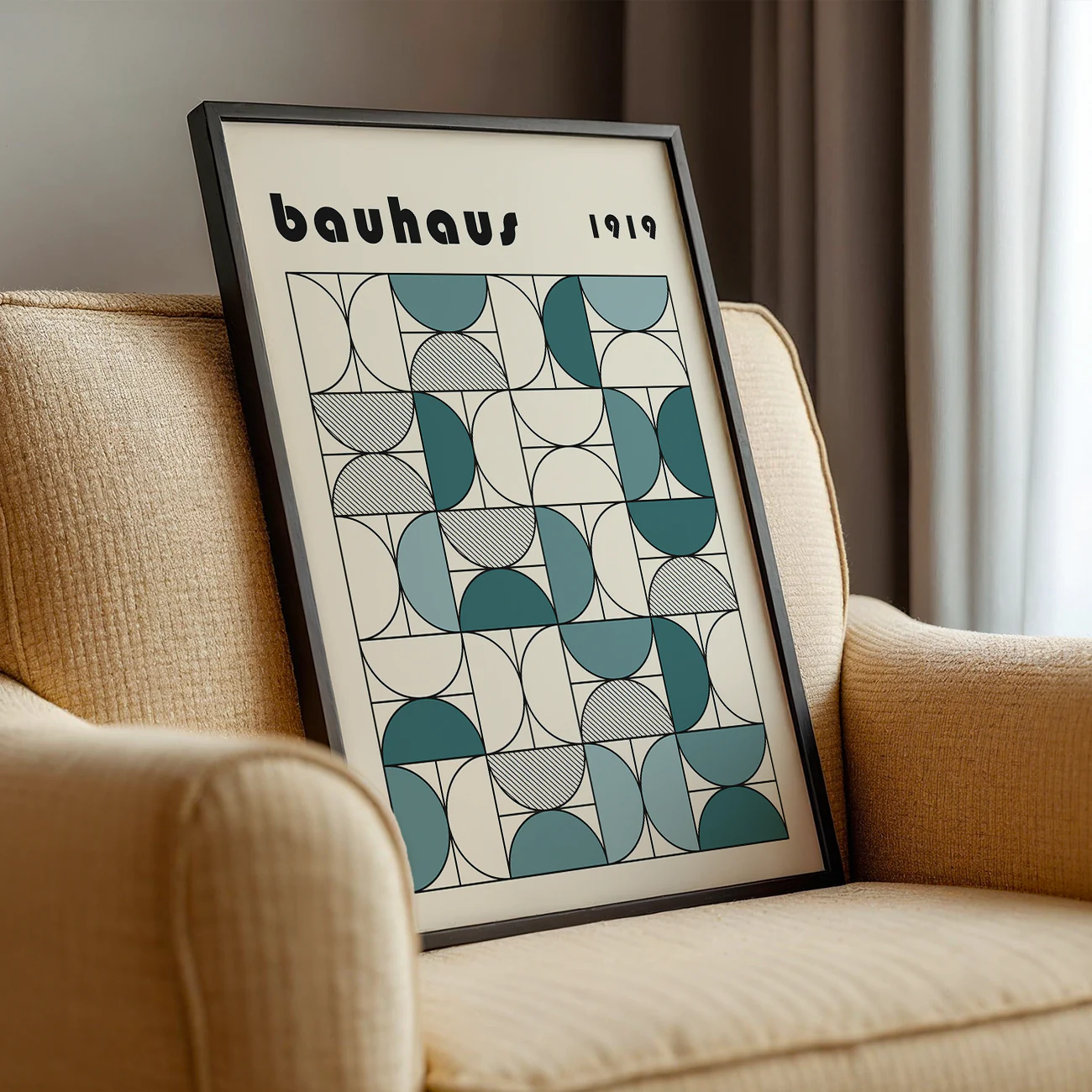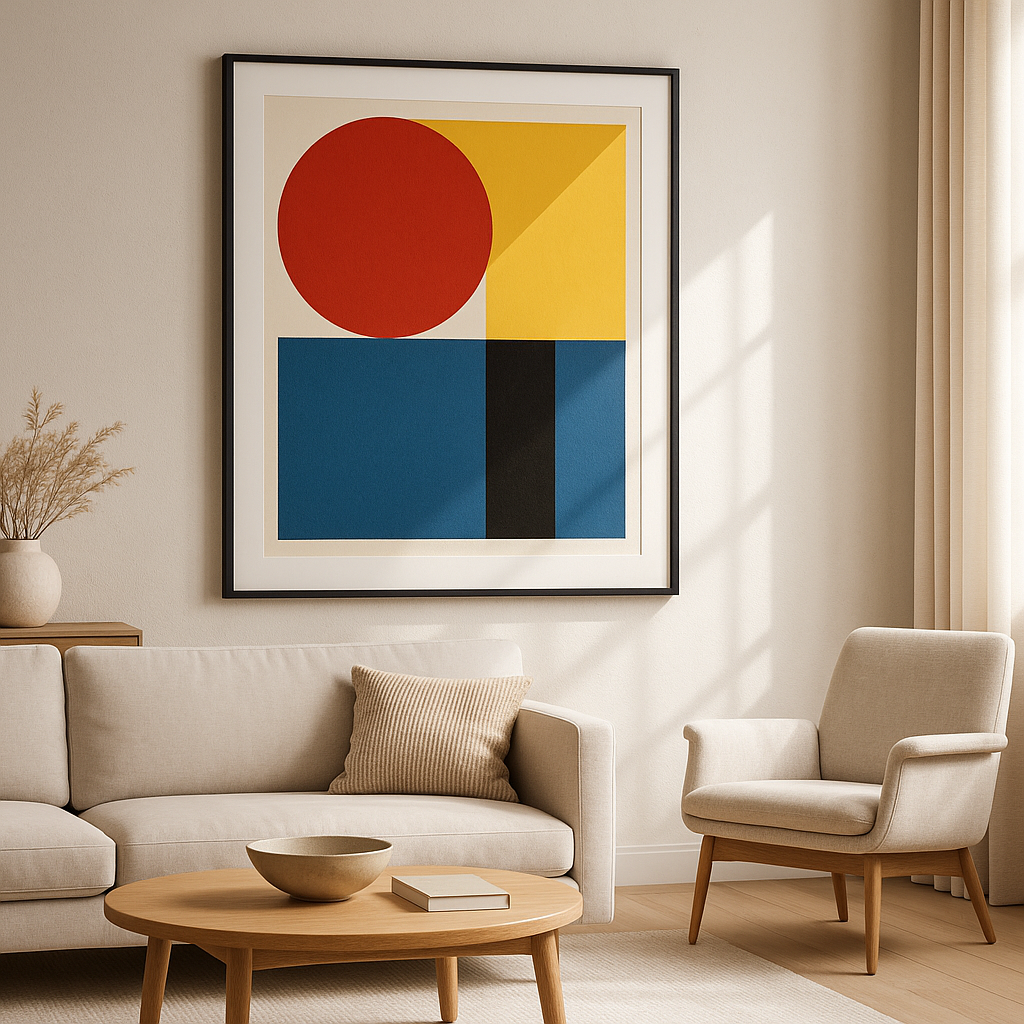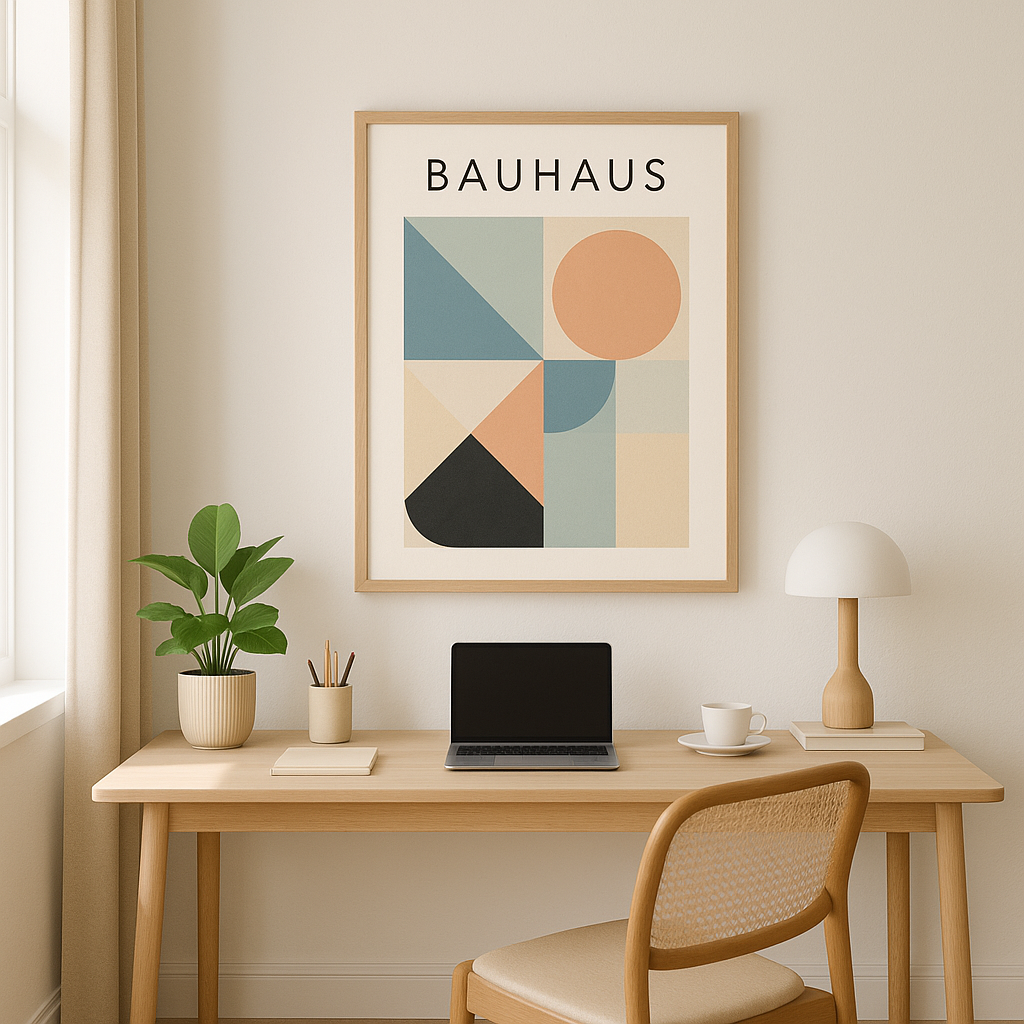Why Bauhaus Art Prints Are Making a Major Comeback

Why Bauhaus Art Prints Are Making a Major Comeback
The clean lines and bold geometric shapes of Bauhaus design are once again commanding attention in interior spaces everywhere.

This isn’t just another fleeting decor trend—it’s a significant revival of one of the most influential art movements of the 20th century. The Bauhaus school, founded in Germany in 1919, revolutionized how we think about the relationship between form and function, creating a distinctive visual language that feels remarkably fresh and relevant a century later.
As our homes increasingly become multifunctional sanctuaries, many are drawn to the purposeful clarity and visual impact that Bauhaus-inspired pieces bring to a space. Vintage is having a major moment. From fashion runways to interior design magazines, the influence of the past is everywhere. Yet the Bauhaus aesthetic stands apart, offering something simultaneously historic and utterly contemporary.
In this article, you’ll discover why this iconic design movement is experiencing such a profound resurgence, how to incorporate these striking prints into your own space, and why they resonate so powerfully with today’s design sensibilities.
What is the Bauhaus movement & why does it resonate today?
The Bauhaus movement emerged from the German art school founded by architect Walter Gropius in 1919. More than just an educational institution, it represented a radical rethinking of art, design, and architecture. The school rejected ornate decoration in favor of streamlined forms, embraced new technologies, and sought to unify all creative disciplines.
At its core, Bauhaus design follows several key principles that continue to feel relevant: form follows function, less is more, and thoughtful design should be accessible to all. The movement’s distinctive visual elements—geometric shapes, primary colors, clean typography, and an emphasis on balance—create art that feels intentional rather than arbitrary.
Today’s renewed appreciation for Bauhaus art prints stems from our collective yearning for simplicity and meaning in an increasingly complex world. The movement’s emphasis on functionality speaks to our modern desire for purposeful possessions, while its bold visual language provides the personality and character many minimalist interiors crave.
From German school to global phenomenon
Though the original Bauhaus school operated for just 14 years before being shuttered under Nazi pressure, its influence spread worldwide as its instructors and students emigrated across Europe and to America. Leading Bauhaus figures like Wassily Kandinsky, Paul Klee, Josef Albers, and László Moholy-Nagy continued developing and teaching these design principles, embedding Bauhaus thinking into educational systems and design practices globally.
This diaspora ensured that Bauhaus principles would influence everything from architecture and furniture to typography and consumer products.

Even today’s digital interfaces owe much to Bauhaus ideas about clarity, hierarchy, and purposeful design. Bauhaus wall art with colorful geometric patterns inspired by 1923 designs offers an authentic modernist flair to spaces, bringing these enduring principles into contemporary homes.
The visual appeal: why geometric & minimalist art prints speak to us
There’s something inherently satisfying about geometric art prints that tap into our natural appreciation for order and harmony. Bauhaus compositions with their careful balance of shapes, lines, and negative space create a visual stability that feels both dynamic and reassuring—a combination particularly welcome in uncertain times.
The movement’s characteristic bold primary colors—red, blue, and yellow—alongside stark black and white create high-contrast visuals that command attention without overwhelming a space. This adaptable boldness allows modernist wall art to function as either a complementary element or a striking focal point in contemporary interiors.
Many interior designers note that abstract prints with geometric elements satisfy our desire for visual interest while avoiding the literal representations that might limit a space’s versatility or quickly feel dated. This timeless quality makes Bauhaus-inspired artwork an investment rather than a passing trend.
How Bauhaus complements modern interiors
The versatility of Bauhaus prints makes them remarkably adaptable across different interior styles. In minimalist spaces, they add personality without clutter. In eclectic interiors, their structured forms create welcome balance amid more organic elements. Even in traditional settings, a well-placed Bauhaus poster can introduce a refreshing contemporary note.
Different rooms benefit from different approaches. Living rooms often welcome larger statement pieces that anchor conversation areas. Home offices gain energy and focus from the movement’s orderly compositions.

Bedrooms might feature softer geometric abstractions in calming color palettes that maintain the Bauhaus spirit without sacrificing restfulness.
Let’s be honest: not everything that looks old is the real deal. Authentic vintage is more than age; it’s about being real, and being rooted in its own era. The current popularity of Bauhaus prints speaks to this desire for substantive design with genuine historical connections rather than empty aesthetic mimicry.
Trend drivers: why the Bauhaus aesthetic is back
Several converging factors explain the resurgence of Bauhaus-inspired decor. First, we’re at a point in the design cycle where the clean minimalism of recent years is evolving to incorporate more personality and historical reference points. The Bauhaus aesthetic perfectly bridges this gap—offering graphic impact and historical substance while maintaining modernist restraint.
The pandemic fundamentally altered our relationship with our living spaces, creating a widespread desire to surround ourselves with meaningful objects rather than disposable decor. Bauhaus designs, with their thoughtful approach to form and function, satisfy this craving for intention in our environments.
Social media has also played a significant role in this revival. The bold, graphic nature of Bauhaus prints makes them immediately recognizable and visually striking in the scrolling environment of Instagram and Pinterest. Their distinctive shapes and primary colors create the kind of visual impact that stands out in digital feeds, introducing these designs to new audiences.
Additionally, as sustainability concerns grow, many are looking to design movements that emphasized quality, durability, and timelessness—all hallmarks of the Bauhaus approach. Unlike fast fashion for homes, these prints represent an investment in enduring design principles.
Retailers and museums have responded to this interest with new collections and exhibitions celebrating Bauhaus design, making these once-specialized art pieces more accessible to mainstream consumers. Bauhaus exhibition poster inspired by 1923 geometric circles offers modernist wall art for creative interiors, allowing anyone to bring this distinctive aesthetic home.
How to style Bauhaus prints: easy tips & curated pairings
Incorporating Bauhaus art prints into your space doesn’t require a complete redesign. These versatile pieces can enhance nearly any interior when thoughtfully integrated. Here are practical approaches to styling these distinctive works:
- Consider scale and placement – Larger prints make powerful statements in living areas and entryways. Smaller geometric works can create interest in transitional spaces like hallways or alcoves.
- Create contrast – Bauhaus prints shine against neutral backdrops but also work surprisingly well with textured surfaces like exposed brick or natural wood that highlight their crisp geometries.
- Build a gallery wall – Mix Bauhaus-inspired pieces with other abstract works, photography, or even botanical prints for an eclectic but cohesive display. Maintain unity through consistent framing or a limited color palette.
- Pair with complementary furniture – These prints naturally harmonize with mid-century modern pieces, minimalist furniture, or industrial elements that share their emphasis on clean lines and function.
- Use color as a bridge – Pull one color from your artwork into small accessories like cushions or ceramics to create subtle connections throughout the space.
When framing Bauhaus prints, simple is often best. Thin black frames echo the movement’s emphasis on clean lines, while natural wood adds warmth. For particularly bold pieces, a generous white mat creates breathing room and heightens visual impact.
Don’t feel constrained by perfect matches—sometimes the most interesting interiors juxtapose the geometric precision of Bauhaus design with more organic or eclectic elements. A Bauhaus print above a vintage sofa or alongside handcrafted ceramics creates compelling visual conversations between different design philosophies.
For those working with smaller spaces, consider how these graphic elements can create depth and dimension. A well-placed geometric pattern can visually extend a room or define functional zones within open-concept living areas.
Conclusion
The resurgence of Bauhaus art prints represents more than just another cycle in the ever-spinning wheel of design trends. It reflects our contemporary desire for visual clarity, historical substance, and thoughtful design in a world often overwhelmed by excess and disposability. These prints offer a connection to one of the most influential artistic movements of the modern era while simultaneously feeling fresh and relevant to today’s interiors.
Whether you’re drawn to the bold primary colors, the satisfying geometric compositions, or the rich design history these pieces represent, Bauhaus-inspired artwork offers an accessible entry point to creating more intentional, visually compelling spaces. The beauty of this revival lies in its adaptability—these prints can transform minimal apartments, enliven family homes, or add graphic punch to professional environments.
As we continue seeking meaningful ways to personalize our surroundings, the enduring principles of Bauhaus design remind us that truly great art finds the perfect balance between expression and restraint, between making a statement and serving a purpose. In bringing these modernist classics into contemporary spaces, we’re not just decorating—we’re participating in an ongoing conversation about what makes design matter.
Frequently asked questions
What defines Bauhaus art prints?
Bauhaus art prints feature bold geometry, primary colors, and minimalist forms rooted in the Bauhaus design school’s modernist principles.
How do I choose the best Bauhaus print for my room?
Consider your room’s color palette, existing decor style, and desired mood. Bauhaus works pair well with either stark minimalism or eclectic vintage decor.
Are Bauhaus prints considered vintage or modern?
While the original designs are historic (1920s–1930s), reprinted or reinterpretations offer a fresh, contemporary twist—making them both vintage-inspired and timelessly modern.
Can Bauhaus art fit with non-modern interiors?
Absolutely—Bauhaus designs can punctuate traditional or bohemian spaces, acting as a bold focal point or subtle accent depending on the size and framing.
Where can I find authentic Bauhaus-inspired wall art?
Look for reputable sellers, artist collaborations, or curated online marketplaces specializing in modernist and vintage-style wall decor.